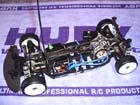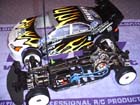| Test Session by Team XRAY UK |

Andy's Moore EVO2 with Composite chassis
(click to enlarge) |
This testing was to establish some useful results and information on certain fundamentals, rather than to fine tune to this particular track. Ashby was chosen for its combination of corners and its bumps which really highlight good and bad car setup.
I hope that this short synopsis may provide useful concluding information, from a very busy test day. Hopefully this report may provide you with useful concluding data to use to your advantage.
TESTED : Weight distribution, T1R Chassis, Damper Pack. |
| T1R Chassis : Andy Childs |

Andy's Moore EVO2 with Composite chassis
(click to enlarge) |
Andy's car was setup to the track during 3 sessions and a benchmark set, using the standard Evo2 chassis. This was then changed to a T1R moulded chassis. It was clear immediately, that the car was easier to drive, and a string of fast and consistent lap times followed as a result. There was a slight increase in front end grip also. The fastest lap times were the same as with the Evo2 chassis, but the car looked more stable. I suspect that the Evo2 chassis could hold advantages for producing the fastest lap time, given higher grip and temperatures, because the higher grip may favour the slightly stiffer carbon chassis of the Evo2, and higher temperatures may slightly soften the moulded T1R chassis.
But in these conditions the T1R chassis, has easier smoother handling and therefore less likely to cause you small or even large mistakes over 5 minutes.
A fully flexible top deck was also tested with Andy Child's and Andy Moore's T1Rs'. The cars showed increased grip and stability in both cases. Although we know from previous testing at Ashby and elsewhere, that the top deck must be changed to stiffer versions as grip level increases. The stiffer top decks prevent mid corner breakaway at the rear of the car, and will increase stability in high grip conditions. |
| Weight Distribution : Lee Wouldhams, Ben Cosgrove |
|
3 runs were used to dial Lee's car, and then a benchmark set. Ballast was moved to the front then rear of the car. The experiment was varied and repeated, with different weights and positions used. Concluding, it was established that the ultimate fastest lap times were achieved with weight forward. More noticably and significantly, with the weight forward, the car was more able to change direction quickly without losing stability (perfect to get safely through a chicane). The standard weight distribution allowed lap times within 1/10th second but only with car driven on the edge, with no chance to make small correction to line or speed once committed to a corner. With weight forward the driver can drive harder with less fear of a mistake. Turning in slightly too early or having to clip a kerb are much easier to handle with the weight forward. You can keep pushing harder. Ben Cosgrove's car, which was setup with cells along one side showed similar characteristics to Lee Wouldhams "ballast forward" setup.
Measuring the weight distribution places forward to back placement of the "Centre of Gravity" as follows :
Standard layout : 48% front, 52% rear (all figures without bodyshell)
Lee's : 49% front, 51% rear (40g of ballast on chassis, just in front of front bulkheads)
Ben's : 50% front, 50% rear (Cells along right hand side of car)
Your C of G can be checked by placing one end of the car onto scales, with the other end supported by a block (The block must be level with the scales platform). With no bodyshell a car weighs approx. 1400g. Therefore the front should measure minimum 686g and the rear maximum 714g. or even front and rear equal at 700g. |
| Damper "Pack" : Ben Cosgrove |
|
After several good consistent runs, new rear dampers were fitted to try to reduce a slight patter at the back of the car, which was most noticable whilst braking into the "rutty" top hairpin. 3 hole fixed piston with 30wt oil were in the car. These were changed to 4 hole fixed pistons with 40wt oil.. The oil was calculated to give the same low speed damping feel. The 4 holes/thicker oil would reduce the high speed damping rate or "Pack". With the new damper setup, the car pivoted through corners a little more, which was an advantage at this track, and with a significant improvement to the "patter" at the top hairpin. I feel that this damper setup would be an advantage in most conditions. Using the 2 or 3 hole pistons, at billiard table smooth, high speed tracks, could be an advantage because extra stability will be achieved without any compromise.
CONGRATULATIONS
To Ben Cosgrove, who took his Xray,Peak, Vega setup to Bedworth the next day, for the first round of the TORC Series. He TQ'd and won taking a new Track Record in the process ! |
|























